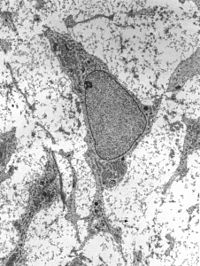
Photo from wikipedia
Chlorpyrifos (CPF) is an organophosphate insecticide described to induce cognitive disorders, both after acute and repeated administration. However, the mechanisms through which it induces these effects are unknown. CPF has… Click to show full abstract
Chlorpyrifos (CPF) is an organophosphate insecticide described to induce cognitive disorders, both after acute and repeated administration. However, the mechanisms through which it induces these effects are unknown. CPF has been reported to produce basal forebrain cholinergic neuronal cell death, involved on learning and memory regulation, which could be the cause of such cognitive disorders. Neuronal cell death was partially mediated by oxidative stress generation, P75NTR and α7-nAChRs gene expression alteration triggered through acetylcholinesterase (AChE) variants disruption, suggesting other mechanisms are involved. In this regard, CPF induces Aβ and tau proteins production and activation of GSK3β enzyme and alters glutamatergic transmission, which have been related with basal forebrain cholinergic neuronal cell death and development of cognitive disorders. According to these data, we hypothesized that CPF induces basal forebrain cholinergic neuronal cell death through induction of Aβ and tau proteins production, activation of GSK-3β enzyme and disruption of glutamatergic transmission. We evaluated this hypothesis in septal SN56 basal forebrain cholinergic neurons, after 24 h and 14 days CPF exposure. This study shows that CPF increases glutamate levels, upregulates GSK-3β gene expression, and increases the production of Aβ and phosphorylated tau proteins and all these effects reduced cell viability. CPF increases glutaminase activity and upregulates the VGLUT1 gene expression, which could mediate the disruption of glutamatergic transmission. Our present results provide new understanding of the mechanisms contributing to the harmful effects of CPF, and its possible relevance in the pathogenesis of neurodegenerative diseases.
Journal Title: Toxicology
Year Published: 2018
Link to full text (if available)
Share on Social Media: Sign Up to like & get
recommendations!